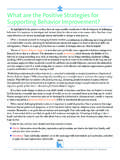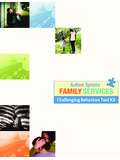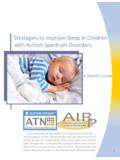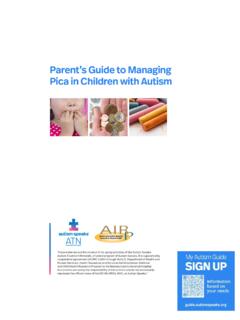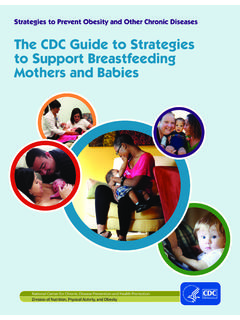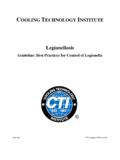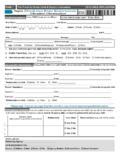Transcription of Pica - Home | Autism Speaks
1 PicaA Guide for ProfessionalsThese materials are the product of on-going activities of the Autism Speaks Autism Treatment Network, a funded program of Autism Speaks . It is supported in part by cooperative agreement UA3 MC 11054, Autism Intervention Research Network on Physical Health (AIR-P Network) from the Maternal and Child Health Bureau (Combating Autism Act of 2006, as amended by the Combating Autism Reauthorization Act of 2011), Health Resources and Services Administration, Department of Health and Human Service to the Massachusetts General Statement: This tool kit is a guide for primary care medical providers unfamiliar with the medical and behavioral treatment of the pica of children with What is Pica? Pica, the repeated eating of non-food items, is the eating disorder most often displayed by children with Autism . In published literature, the most common definition of pica is the placing of non-edible items past the plane of the lips.
2 For example, a child may eat food from a garbage can or bite off a piece of a toy plastic car and swallow it quickly. Other children hold things in their mouths and move them around only swallowing the item occasionally. Among individuals with Autism , pica is more common among those who have an intellectual disability compared to individuals with average or above average is diagnosed using four specific criteria:Children with Autism have been reported to eat a wide variety of items. Common targeted items include: Chalk Cigarette butts Clay Clothing or thread Coins Dirt Feces Hair Large amounts of ice Paint chips Paper Plants or grass Plaster Rocks, pebbles or wood chips Rock salt Rubber bands Shampoo Any other non-food item Persistent eating of one or more non-food items. Behavior that is developmentally inappropriate and not part of a culturally sanctioned practice.
3 Behavior that occurs often enough to warrant independent clinical attention. Age greater than 18 months. Mouthing of objects is considered developmentally appropriate behavior for children under 18 months. However, if the ingestion of non-edible objects is very frequent, then early treatment for pica might be warranted in children under 18 Targeted Pica ItemsTypically, pica is diagnosed by a healthcare provider such as a psychologist, primary care provider or medical and Prevalence of PicaBased on published literature, pica appears to occur fairly frequently in children and adults with Autism and other developmental disabilities. No studies of the clinical incidence and prevalence of pica in children and adults with Autism living in community-based settings have been published (Ali, Z, 2001).PICA tool kit for Primary Care Providers presented by Autism Speaks ATN/AIR-PPICA tool kit for Primary Care Providers presented by Autism Speaks Nutritional deficiencies in iron or zinc (See recommended readings for more information).
4 Sensory- seeking behaviors ( , automatic reinforcement); some children eat non-food items to get some sort of pleasurable or enjoyable feeling. Lack of understanding of the difference between edible and inedible objects. Hemoglobin/hematocrit. Iron studies (ferritin, TIBC, serum iron). Serum zinc level. Test for parasites if there is reason for concern ( , worms or larvae in the stool or other clinical symptoms). Supplementation with iron if anemia or low iron stores identified. Supplementation with zinc if low levels identified. Evaluation by a registered dietician, especially if child is on a special diet or has significant dietary selectivity. Does the child search the environment ( , classroom or home ) for items to place in his/her mouth? Does the child frequently eat non-food items? Does the child frequently hold non-edible items in his/her mouth ( , rocks, wood chips)?
5 Do other people such as grandparents or baby sitters report that the child places non-edible items in his/her mouth? Do you find non-edible items in the child s stool ( , beads, small rocks)?Children with pica require careful health monitoring in order to a) identify medical factors that may be contributing to pica behavior and b) identify and treat health risks of the etiology of pica is not completely understood, a number of factors are thought to contribute. These include:Important questions to ask parents or educators of children with Autism to screen for pica:Evaluation for medical contributors to pica behavior:Treatment of etiologic factors may include:A basic work-up for the etiology of pica should include:ASSESSMENT PROTOCOL FOR PRIMARY CARE Lead: Children with pica are at increased risk for elevated lead levels. Regular monitoring of serum lead levels should continue beyond the toddler years, for as long as the child continues to put non-food items in his or her Dental erosion and other dental health problems: Regular dental care is needed to monitor for oral and dental complications of pica such as excessive tooth Gastrointestinal complications: Children with pica are at increased risk for a variety of GI complications.
6 These may include constipation, ulcerations, perforations, diarrhea, parasites, nutrient malabsorption and bowel obstruction. Regular screening for frequency and consistency of bowel movements, appetite and eating patterns and abdominal pain or discomfort are needed, with further evaluation when abnormalities are identified. Since children with Autism often do not communicate pain effectively, attention to behavioral changes is an important part of assessing pain. Symptoms such as irritability, tantrums, aggression and self-injury may be present in a child who is experiencing for health risks of pica:PICA tool kit for Primary Care Providers presented by Autism Speaks ATN/AIR-PPICA tool kit for Primary Care Providers presented by Autism Speaks ATN/AIR-PPica behavior must always be taken into account when a child is evaluated for acute illness. Children with pica are at increased risk for bowel obstruction, bezoars and Review lab work, including.
7 CBC with differential, ferritin, TIBC, serum iron and ESR Serum zinc Serum lead Stool O & P (consider if diarrhea present)2. Counsel family re: minimizing unsafe items in child s Counsel family re: appropriate supervision to maintain safety in all Consider referral to a registered dietician for assessment of nutritional sufficiency in children with selective diets or those on special Supplement iron and zinc when low levels are found on blood Supplement calcium, phosphorus, Vitamin C when insufficient dietary intake is identified. Presence of other chronic medical conditions (sickle cell disease, iron deficiency, etc.) Past illnesses (particularly GI, aspiration, other pulmonary illnesses)Primary Care Assessment of a Child with Pica:Review of Systems:Past Medical History:Plan:Assessment of acute illness in a child with pica:Behavioral Status:Pica: frequency of behavior, current substances put in mouth, ingested or spit mouthing behavior: whether child chews on clothes, toys, : disruptive behavior: tantrums, aggression, repetitive behavior or sensory-seeking behavior: stereotypical behavior or : constipation, diarrhea, abdominal pain, : presence of selectivity, special diet, allergies, as well as usual dietary intake, with particular attention to presence of sources of iron, calcium and.
8 General feeding habits (meals, snacks, grazing), location of feeding (at table, wandering around house, in front of TV), presence of other problematic feeding behaviors such as aerophagia ( , air swallowing), rumination, disruptive mealtime behavior, food : regular dental care, presence of dental erosion or other tool kit for Primary Care Providers presented by Autism Speaks Interventions for Primary Care Physicians:Pica, the repeated eating of non-food items, is the eating disorder most often displayed by children with Autism . In published literature, the most common definition of pica is the placing of non-edible items past the plane of the lips. For example, a child may eat food from a garbage can or bite off a piece of a toy plastic car and swallow it quickly. Other children hold things in their mouths and move them around only swallowing the item occasionally. Among individuals with Autism , pica is more common among those who have an intellectual disability compared to individuals with average or above average assessments of pica can help identify the triggers for pica and whether pica is maintained by non-social (automatic reinforcement or sensory-seeking behavior) or social factors (attention from parents).
9 A complete behavioral assessment of the cause of pica may be critical to its successful treatment. Behavioral researchers have demonstrated that interventions based on a comprehensive behavioral assessment are more likely to produce a clinically significant reduction in pica. Primary care physicians should refer a child with Autism and pica to either a board certified behavior analyst or psychologist with training in behavior analysis and treatment of problem behavior of persons with Autism . Some parents might need a prescription or a doctor s referral to access the services of a behavior analyst or ) Environmental arrangements ( , locks on cabinets)2) Environmental enrichment ( , promoting the child s engagement in functional activities such as getting dressed, looking at books, etc.)Behavioral interventions that can be implemented by the parents without coaching from a behavioral specialist include:1) Teaching alternative skills ( , throwing pica items away or giving them to an adult)*2) Non-contingent presentation of items or food**3) Response blocking**4) Differential reinforcement strategies (DRO;DRA); Reinforce eating of food items and do not reinforce eating of non-food items.
10 **5) Behavioral reductive strategies ( , hands down, overcorrection); If family is using behavioral reductive strategy without training or coaching from an expert, the provider should counsel the family and provide a behavioral interventions have been found to be effective and may require the support of a behavior analyst. Consult with a behavioral analyst if you want to try the interventions below:**Behavioral Assessment of Pica:PICA tool kit for Primary Care Providers presented by Autism Speaks ATN/AIR-PRESOURCESAli, Z. (2001). Pica in people with intellectual disability: A literature review of aetiology, epidemiology and complications. Journal of Intellectual & Developmental Disability, 26, 205 , C., & Rubin, H. B. (1993). Effects of a nutritional supplement on coprophagia: A study of three cases. Research in Developmental Disabilities, 14, 445 , S. L., Wheeler, J. J., &Mayton, M. R. (2004).
